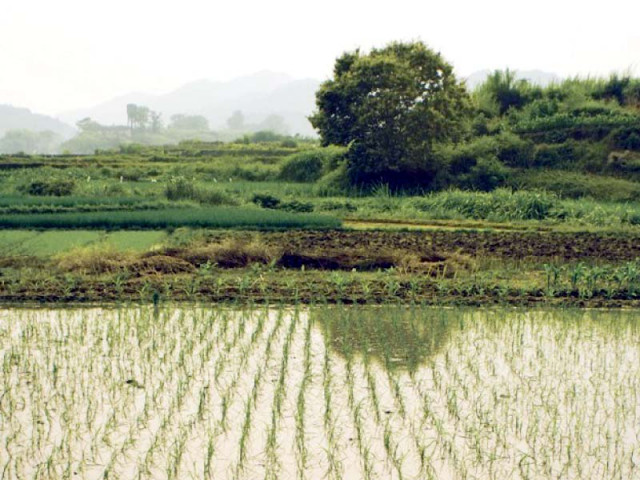Rice production: Losses six times more than cash support, says farmers
They are not content with Rs5,000 per acre relief offered in PM’s package

Average paddy productivity is very low compared with regional competitors where the yield is double than the production in Pakistan, which is the fourth largest exporter of rice in the world. PHOTO: FILE
A Rs341-billion agriculture relief package announced by Prime Minister Nawaz Sharif earlier this week has not won hearts of all that are associated with the country’s farms.
Growers of paddy crop, who are perturbed about falling prices of rice in domestic and international markets, argue that the cash support of Rs5,000 per acre, offered in the package, is not sufficient to make up for the losses they are enduring.
They claim that the losses have jumped to Rs30,000 per acre, which is six times more than the incentive given to them. Owing to the market slump, the price of new paddy crop stands 30% lower than last year, farmers say. However, the crop is bumper and healthy as it has been protected from pest attack.
The government has set aside Rs40 billion for paying the cash grant of Rs5,000 per acre to rice and cotton growers owning up to 12.5 acres of agricultural land.
According to agricultural experts, basmati rice gives yield in the range of 35 to 45 maunds (40kg) per acre, super basmati gives 40 to 45 maunds, non-basmati varieties give 50 to 60 maunds and 386 non-basmati variety produces 45 to 50 maunds.
The average paddy productivity is very low compared with regional competitors where the yield is double than the production in Pakistan, which is the fourth largest exporter of rice in the world.
“Indians are very good in agriculture research and development work and scientists there have developed such paddy seeds that give more than 70 maunds per acre,” said Naseer Ahmad, an agricultural expert, while talking to The Express Tribune.
Last year, the price of basmati rice stood at Rs1,400 to Rs1,600 per maund, but now it has dipped to Rs1,000 to Rs1,100.
The 386 non-basmati variety fetched Rs1,000-1,100 per maund last year and the price has now gone down to Rs650-700, according to Taufeeq Ahmad, a rice exporter and former vice-chairman of the Rice Exporters Association of Pakistan.
He voiced fear that the massive decline in prices would hurt earnings of exporters and he also pointed to high transportation and shipping costs borne by them. “The government should give freight subsidy to rice exporters,” he said.
Last year, the exporters earned $1.84 billion, but Ahmad believed that it would be impossible to touch that figure this year following the slump in international commodity markets. Now, the exporters are looking to make inroads into the Iranian rice market. “If Iran starts importing rice, the farmers can recoup their losses,” Ahmad said.
However, international buyers are looking perplexed because of wild price movements. Last year, many of them sustained heavy losses after international prices fell below their purchase price. “Many rice traders of the United Arab Emirates (UAE) faced bankruptcy too,” Ahmad said.
He pointed out that the 386 variety had great demand in the UAE, Iran, China and African nations but price fluctuations kept international traders away.
Published in The Express Tribune, September 20th, 2015.
Like Business on Facebook, follow @TribuneBiz on Twitter to stay informed and join in the conversation.



















COMMENTS
Comments are moderated and generally will be posted if they are on-topic and not abusive.
For more information, please see our Comments FAQ